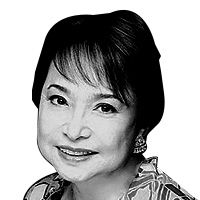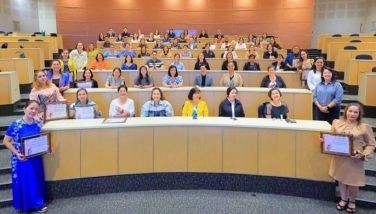Good as gold

January 8, 2006 | 12:00am
 It was always the same position. Face down with nothing but a flimsy sheet of wax paper to keep my head steady and my nostrils opened. This was no kama sutra or art of seductive poses; it was the opposite. I was undergoing therapy and rehabilitation for my lower back with Dr. Martin Camara, the senior chirop-ractic specialist at Intercare.
It was always the same position. Face down with nothing but a flimsy sheet of wax paper to keep my head steady and my nostrils opened. This was no kama sutra or art of seductive poses; it was the opposite. I was undergoing therapy and rehabilitation for my lower back with Dr. Martin Camara, the senior chirop-ractic specialist at Intercare.
Dr. Camara said to me, "If you are in any kind of pain, call me on my cell phone because I’m not going to be at the clinic."
"Are you going abroad?" I asked.
"I’ll be in Laguna with our SEA Games athletes," he replied.
Two weeks passed without any untoward incident. I was flat on my back when one of the physiotherapists, Jose Allan Aban, came around to my treatment room to prepare my back for ultrasound and intercurrent stimulation.
"Ma’am, have you been watching the SEA Games?" Allan asked. "I saw how our swimmers, our gymnasts, our wushu athlete, our arnis players, and just about every Filipino athlete who participated in the Games made a clean sweep of the medals."
"I was there!" he exclaimed.
The Intercare team had set up mobile clinics at Trace College, Los Baños, Laguna, under the diving platform next to the main competition pool to work closely with the swimming team. They became such a sight to the Filipino team that they were called the pain busters on standby.
Allan said, "It was very exciting. Everybody had a feeling of what to do to make sure that our swimmers performed at their optimum best. If anyone but raised a complaint about aching joints or stiff muscles, we had him flat on his back."
The result was astounding. Allan said, "When I heard a coach say that a swimmer did a fantastic job (gold or silver or bronze), I felt as if I contributed to that victory."
The next day, I got a call from Sheryl, the Intercare secretary: "You can resume your Pilates class with Ice Vivero."
I hope I can still scoop my abdominal muscles the way she taught me, I thought to myself.
"Did you watch the SEA Games?"
"Yes," I replied. "I can’t believe how well our athletes performed."
"Dr. Camara asked me to be the coordinator so that we could put together a comprehensive and smooth health treatment program to benefit all the participants before, during and after the competitions," Ice said.
Ice told me that their first week in Laguna was spent making a profile of each athlete. This was followed by the actual treatment where chiropractic, Graston tools, myotherapy, physical therapy and even acupuncture were performed on each athlete.
The athletes were so amazed at how well they felt. They made it a habit to drop by the clinic even after the clinic was closed for the day just to hang around for a laugh or two.
By the time the SEA Games opened, a different setup was put in place.
"We kept long hours," Ice said. "I was on tenterhooks, especially when I watched them perform their fancy dives, knowing how their particular injury might or might not deliver the gold. There was one diver who suffered a bad injury on her ankle but she got the gold."
Another member of the Intercare team, Dr. Serry Alfonso Pizarro II, spoke of the discipline and commitment of the athletes despite their tender ages. He laughed as he recalled how little they knew about chiropractic care. "They had no idea what we were all about," Pizarro said.
Dr. Camara said, "The concept was actually very simple. If we could liberate everyday people from the agony of lower back pain and other pain syndromes so that they could enjoy a pain-free life and even play tennis or golf, why not our elite athletes?"
His team therefore introduced sports enhancement programs for the SEA Games, which was brought to the attention of Mark Joseph, president of the Philippine Amateur Swimming Association.
"If the body was properly aligned, the joints were articulating well with each other, the muscles were free of scar tissue, knots and inflammation, then the athletes had a better chance of optimizing their performance/skill levels, " Dr. Camara added.
Here are some of the highlights, according to Dr. Camara.
It was the last day of the swimming meet. Fifteen minutes before the race, Raphael Chua jumped out of the warm-up pool complaining that he seemed to have lost his strength, particularly on his left hip and leg. He was brought to our clinic and we found the muscles of his hip and leg had gone into mini-contractures and his pelvis was slightly misaligned. I worked out the contractures using a muscle energy release and the Graston Technique tools (steel rods that are rubbed on the flesh to address scar tissue) and in less than two minutes he was up and about.
JB Walsh was nauseous after his silver medal win in the 200-meter butterfly competition. His next competition was in 10 minutes so he went straight to our clinic. Our physical therapist used a micro-current machine over his right acupuncture point for nausea while I simultaneously worked on his left using the Graston tool. JB stood up and went straight to his next competition, winning a bronze.
Ryan Fabriga just earned a gold in synchronized swimming. He sprained his wrist as he plunged into the water from a platform. We quickly treated his sprain with electric current, ultrasound, Graston tools to organize the scar, an ice pack and microcurrent. We also taped his hand to prevent further injury.
The problem was that after 24 hours, he had to do a handstand on a sprained wrist as part of his diving routine. Dr. Camara alerted the coach but once the dive routine was submitted to the game officials, there was no way of changing it into a non-handstand dive.
Ryan was treated several times that morning and we taped his injured hand. He had to make six consecutive dives, after which his total score was computed. In between his dives, Ryan was getting microcurrents to ease his pain, an ice massage to lessen the inflammation and renewed taping to stabilize his joint.
On his sixth dive, he went into the handstand from a 10-meter-high platform. The wind shifted, forcing Ryan to place all his weight on the sprained hand. He had to go down from his handstand and then proceeded to go back on it again and execute a flawless dive. His total points earned, with the difficulty factor, positioned him for the gold medal. But because of his need to go back down again, he was penalized by each judge. He lost a total of 12 points, stripping him of the gold. But his lead was so far ahead of everyone else’s that he still earned enough points to get the silver medal.
Sheila Mae Perez won three gold medals. She had a lot of pain on the underside of her foot, which our spring ligaments are connected to. A couple of myofascial-release techniques were all that was needed to restore flexibility and movement to the joints.
While the athletes cried, "Go for gold," the Intercare team made sure they were good as gold.
BrandSpace Articles
<
>















